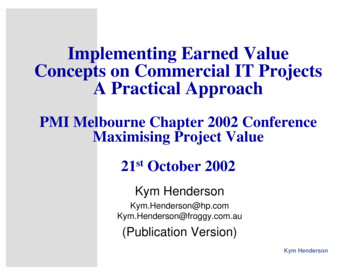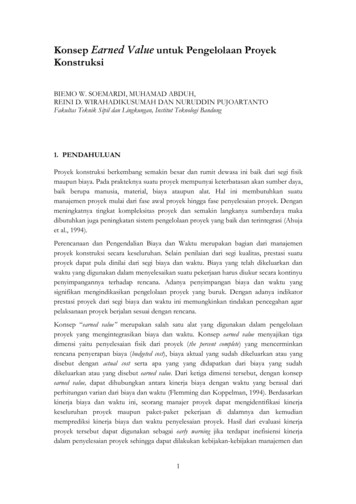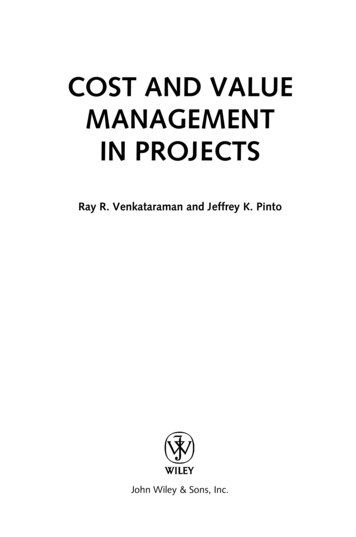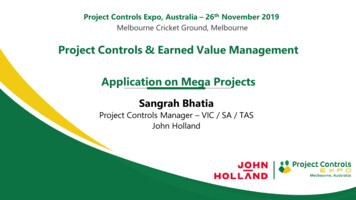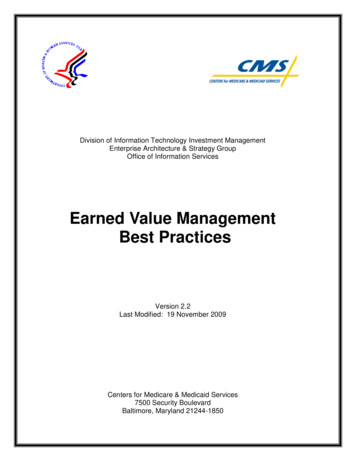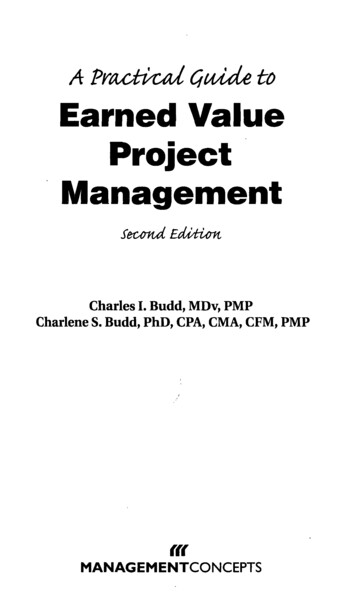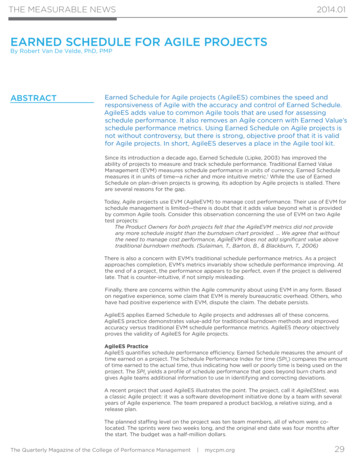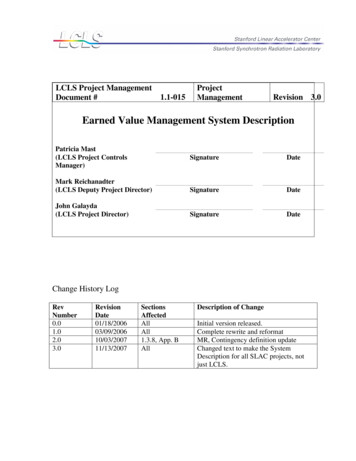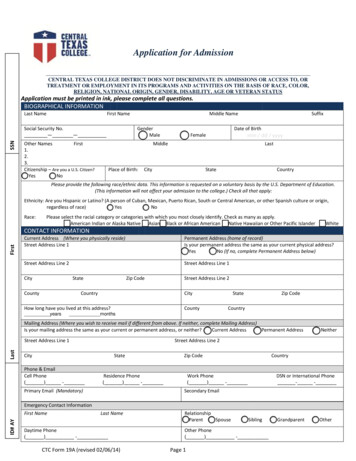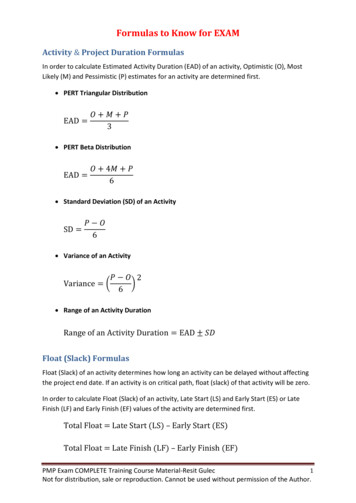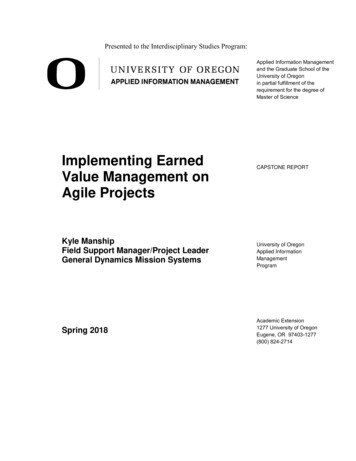
Transcription
Presented to the Interdisciplinary Studies Program:Applied Information Managementand the Graduate School of theUniversity of Oregonin partial fulfillment of therequirement for the degree ofMaster of ScienceImplementing EarnedValue Management onAgile ProjectsKyle ManshipField Support Manager/Project LeaderGeneral Dynamics Mission SystemsSpring 2018CAPSTONE REPORTUniversity of OregonApplied InformationManagementProgramAcademic Extension1277 University of OregonEugene, OR 97403-1277(800) 824-2714
Approved byDr. Kara McFallDirector, AIM Program
Running head: EARNED VALUE ON AGILE PROJECTSImplementing Earned Value Management on Agile ProjectsKyle ManshipGeneral Dynamics Mission Systems1
EARNED VALUE MANAGEMENT ON AGILE PROJECTS2
EARNED VALUE MANAGEMENT ON AGILE PROJECTS3AbstractThis study addresses the problem of implementing and integrating earned valuemethodologies on Agile projects. The intended audience is program and technical managers andteam members on projects that lead functional groups. In a broader sense, the audience is keyproject stakeholders. This study is significant because Agile has rapidly emerged, yet traditionalearned value methods are still in place in many industries and organizations. This studyaddresses the compatibility between the two methods.
EARNED VALUE MANAGEMENT ON AGILE PROJECTS4
EARNED VALUE MANAGEMENT ON AGILE PROJECTS5Table of ContentsAbstract . 3Introduction to the Annotated Bibliography . 7Problem Description . 7Purpose Statement . 9Research Questions . 10Description of Audience . 10Search Report . 11Documentation Method . 13Reference Evaluation . 13Annotated Bibliography . 15Introduction to the Annotated Bibliography . 15Earned Value Management Techniques . 15Agile Project Management Methodologies . 22Application of Earned Value Management Techniques on Agile Projects . 26Conclusion . 35Introduction to the Conclusion. 35Earned Value Management Techniques . 35Application of Earned Value Techniques on Agile Projects . 38Concluding Thoughts . 40
EARNED VALUE MANAGEMENT ON AGILE PROJECTS6References . 41
EARNED VALUE MANAGEMENT ON AGILE PROJECTS7Introduction to the Annotated BibliographyProblem DescriptionProject management requires the addressing many objectives (Cioffi, 2006). The threemost important objectives of project management are successful execution of schedule, accuracyof work performed, and maintaining costs within the allocated budget (Chen, H., Chen, W., &Lin, L., 2016). Many projects fail to meet one or all of these objectives (Gulla, 2011). Gulla(2011) studied historical Information Technology (IT) project success and found that at a lowpoint in 1994, only 16% of information technology related projects were successful. Gulla(2011) also demonstrated that more recent data showed that approximately 34% of IT projectswere successful in 2011.One approach that can help ensure projects are executed on time and on budget is the useof earned value management (McMahon, 2006). Earned value management was initially adoptedby the United States Department of Defense in the 1960s. As earned value management becamemore widely accepted in projects outside of the Department of Defense, it became more of astandard project management tool in the 1980s (McGregor, Kastelnik & Nelson, 2017). Otherindustries realized the benefits of earned value management established with the Department ofDefense methods for the abilities for accurate forecasting, close schedule and budget monitoring,and overall program performance evaluation (McGregor, Kastelnik & Nelson, 2017).Earned value management is defined as a technique for measuring project performanceand progress through the measurement and analysis of scope, time, and cost (Browning, 2014).Earned value management integrates the areas of technical performance, schedule, workperformed, and actual cost to provide metrics for actual work performed and actual cost atcompletion (McMahon, 2006). Essential features of any earned value management
EARNED VALUE MANAGEMENT ON AGILE PROJECTS8implementation include a project plan that identifies work to be accomplished, a valuation ofplanned work, and metrics to quantify the accomplishment of work (McMahon, 2006).In spite of the benefits traditional earned value management can provide, challenges inapplying earned value techniques arise when applied to Agile projects (Verzuh, 2004). Hoda andMurugesan (2016) describe Agile methodologies as characterized by the division of tasks intosmall, rapid tempo groups. Hoda and Murugesan (2016) note that these groups are typically selfdirected and use rapid and ever changing development, broken into iterations called sprints, tomeet customer needs and remain flexible to requirements and test results. Agile projects involvethe constant evolution of requirements and solutions based on these collaborative efforts of selforganizing, cross-functional teams and their customer(s) (Hoda & Murugesan, 2016).Hoda and Murugesan (2016) note that there are several benefits to employing an Agilemethodology. Agile allows for rapid changes if needed, improves quality by breaking down theproject into manageable units, allows for predictable project costs and schedule due to theemployment of sprints, provides transparency through frequent communication with thecustomer, and allows for early and predictable delivery through rapid feature releases andupdates. Projects that employ Agile methodologies, especially software development projects,are also more likely to be considered successful than projects where waterfall methodologies areemployed, especially in the areas of flexibility, rapidly changing requirements, a high level ofcustomer engagement, and changing deadlines (Mihalache, 2017).There are many benefits to employing an Agile methodology, but Agile projects alsoexperience challenges and sometimes failure (Chen et al., 2016). As Hoda and Murugesan (2016)state, Agile project management can lack the focus of working towards an initial, core goal as aresult of such rapid change and small group think. Agile can also present the challenge of
EARNED VALUE MANAGEMENT ON AGILE PROJECTS9addressing and accepting slow changing requirements, as a slower customer does notaccommodate as well to an Agile methodology.While Agile projects do face inefficiencies and even failure, traditional views of earnedvalue management – a method that has been shown to increase the likelihood of project success –assert that the method is too difficult to implement on Agile projects (McMahon, 2006). Onechallenge is the inability of earned value management methods to cope with the associatedchanging requirements and rapid development of Agile project tasks (Nikravan & Forman,2010). Planning baselines and functional requirements, key elements of earned valuemanagement, traditionally do not have the flexibility needed to stay within the framework ofAgile execution (Nikravan & Forman, 2010).Agile methodologies represent a widely accepted way of executing a project (Cioffi,2006). In order to address the problems of inefficiencies and failure that can arise on Agileprojects, the processes and standard practices of earned value management must be adapted forAgile methodologies (Cioffi, 2006). According to Larson and Gray (2014), earned valuemanagement is the accepted method of program management for many industries and specialties,and project and program managers are therefore presented with the challenge of balancingtraditional earned value management approaches with the newer methods of Agile projectmanagement and execution. This annotated bibliography examines the challenges of applyingearned value management techniques to Agile projects and provides sources that address bestpractices in applying earned value management to these projects.Purpose StatementThe purpose of this study is to examine selected literature and other scholarly sources toprovide a framework for the application of earned value management to Agile methodologies.
EARNED VALUE MANAGEMENT ON AGILE PROJECTS10Techniques, best practices, and lessons learned are presented for the project and programmanagement audience, as well as technical leaders who contribute to a project through Agileengineering and system development.Research QuestionsMain Question. How can earned value management be modified, streamlined, andupdated for Agile projects to enable effective project tracking and management?Sub-questions. What, if any, compromises need to be made to employ earned value managementon Agile projects? What are current techniques for the implementation of earned value managementfor Agile project execution?Description of AudienceMost program and project managers that utilize earned value management know itsstrengths and limitations (Cioffi, 2006). Earned value holds program managers accountable tothe premise that execution must be reliable, timely, accurate, and auditable (McGregor, J.,Kastelnik, K., & Nelson, D., 2017). Program and project managers who want to use earned valuemanagement on Agile projects face the additional complexity of rapidly changing requirements,a high level of customer involvement, and a higher level of collaboration with teams, which arecharacteristics of Agile project execution (Hoda & Murugesan, 2016). Program and projectmanagers will benefit from this study through the presentation of empirical, academic researchthat will aide with program and project execution.Agile development and engineering using the Agile methodology must maintain abalance between engineering leadership and program management (Chen et al., 2016). Agile
EARNED VALUE MANAGEMENT ON AGILE PROJECTS11developers and engineers will benefit from this study because it will help to align roles andresponsibilities amongst technical and program leadership. Data will be presented thatdemonstrates the ability for technical management to remain rapid and flexible, while programand project managers can stay on budget, on schedule, and on task through earned valuemanagement practices.Search ReportSearch Strategy. The search strategy involved using keywords related to the subjectmatter. Searches with the full string of earned value management returned favorable results.Google Scholar proved to be a useful engine to help narrow certain search criteria, such asviewing common results that were returned with various search strings used. For example, keyterms such as Agile also returned words such as Scrum, sprints, and cross-functional teams.Primarily, however, using basic search strings in the UO Library databases yielded favorableresults.Searches on earned value management returned ample resources in the UO Librarydatabases, especially in the categories of Business and Economics. Using basic search stringscombining the terms earned value management and Agile also yielded positive results. Basicsearches provided returns of peer-reviewed, scholarly articles and published works. A date filterwas not used, as earned value management is an established practice that can be referenced sinceinception. However, sources within ten years of publishing were primarily used due to changesin the application of earned value management in recent history. On occasion, when a referencewas relevant to modern implementation of the subject matter, older sources were selected.Google Scholar was also used to retrieve sources on the subject matter, yielding marginal resultsdue to the return of many non-scholarly sources and the requirement for payment for other
EARNED VALUE MANAGEMENT ON AGILE PROJECTS12material. Many of the items returned were magazine or periodical publications, some of whichwere scholarly in nature and/or peer reviewed.Key Terms. Searches utilized various keywords in order to retrieve relevant results. Thekeywords used are as follows: Earned Value Management. Earned Value Management and Agile. Agile Project Management. Program Management and Agile Development. Scrum Management. Engineering Program Management. Agile Project Management Methodologies Earned Value Management Techniques Applying Earned Value to AgileSearch engines and databases. The search for relevant and reputable literature mainlyinvolved searches of UO Library databases and Google Scholar. The UO Library’s databasesthat proved relevant for this study include the following: EconLit. Academic Search Premier. Business Expert Press. Business Source Complete. JSTOR.
EARNED VALUE MANAGEMENT ON AGILE PROJECTS13Documentation MethodDocumentation Approach. References and documentation were tracked using basicMicrosoft Windows Save functions to a directory. Material was pulled from a given database,typically in Adobe Portable Document Format (PDF), and filed manually in an applicable folder.Titles of the files were modified locally to use name(s) of the author(s) and brief titles relating tothe subject matter. The running annotated bibliography of this document was used for websitereference when applicable; for instance, to quickly reference websites previously retrieved. AMicrosoft Excel file was used to track titles, dates of retrieval, specific subject matter, and otherpertinent categorization data.Reference EvaluationReference evaluation criteria. References were evaluated using the list of criteriaretrieved from the document Evaluating Information Sources (Center for Public Issues, 2014).The criteria listed in the document are defined as authority, timeliness, quality, relevancy, and(lack of) bias (Center for Public Issues, 2014). A reference was determined to be authoritative ifit was peer-reviewed and if the author has professional credentials, such as advanced degrees orother published books and articles. A source was determined to be current if it was publishedwithin the last ten years to ensure that the most recent practices were reflected. The concept ofearned value management has been widely employed in project management since the 1980s,and the author of this study therefore considered material of all ages, but publication dates olderthan 2008 were mostly excluded.The author of this study reviewed the quality of each reference to ensure proper grammar,spelling, and punctuation, as well as the flow of the information provided to ensure it was clearand well structured. Relevancy was determined by whether the source was appropriate to the
EARNED VALUE MANAGEMENT ON AGILE PROJECTS14research topic of the application of earned value management in Agile projects. Additionally,scholarly sources were prioritized over popular sources. Each source was analyzed for bias bylooking for cited sources that supported the arguments and conclusions of the author(s). Theliterature was also checked for the inclusion of multiple viewpoints. The literature was rejected ifthe author or article was in the position of selling products or services.
EARNED VALUE MANAGEMENT ON AGILE PROJECTS15Annotated BibliographyIntroduction to the Annotated BibliographyThis annotated bibliography addresses the research problem of implementing andintegrating traditional earned value methodologies on Agile projects. The intended audience isboth program-level and technical-level management, as well as team members on a project thatmay lead a functional group. In a broader sense, the audience consists of key stakeholders of aproject. The time period analyzed for this annotated bibliography is from 2006-2018.This study is significant due to the reality that there has been a rapid emergence of Agilemethods, yet the traditional project and program management methods of earned valuemanagement are still in place in many industries and organizations. This study addresses ways toovercome incompatibility between the two methods.Earned Value Management TechniquesBrowning, T. (2014). A quantitative framework for managing project value, risk, andopportunity. IEEE Transactions on Engineering Management, 61(4), stract. Projects should create value. That is the desire and plan, but uncertaintiescloud the paths to this destination. All project work should add value in terms of both theresources consumed and the benefits provided (e.g., scope, quality, technicalperformance, features, and functions), yet adding value is not always straightforward.Conventional techniques such as earned value management focus on time and cost but donot address quality, uncertainty, risk, and opportunity. An integrated approach is neededto account for all of these. This paper presents an integrated framework for quantifyingand monitoring project value in terms of the key attributes that matter to its stakeholders.
EARNED VALUE MANAGEMENT ON AGILE PROJECTS16The framework distinguishes four types of project value: desired, goal, likely, and actual.Project management is value management. Project goals, capabilities, risks, andopportunities are evaluated with respect to each key attribute of the desired value. Theproject value, risk, and opportunity framework is useful for project planning, monitoring,control, and tradeoff decision support. An example project, developing a drone aircraft,demonstrates the framework's application to project planning and monitoring, includingsetting project goals that balance risk and opportunity. New indices for risk, opportunity,and learning are introduced to track project progress and operationalize new constructsfor researchers.Summary. Although this source did not directly address Agile and earned valuemanagement and how they interrelate, it did describe some drawbacks of earned valuesuch as challenges in addressing uncertainty, evaluating risk, assessing opportunity, andmonitoring quality. This source centers around the PVRO (Project Value, Risk, andOpportunity) framework to address these challenges. The author notes that all of thesefactors derive from the key attributes that matter to a project’s stakeholders. Use of thePVRO framework forces project managers to define important value attributes anduncertainties at the beginning of a project. The PVRO framework produces the outputs ofa project’s goal value, likely value, the goal value gap, overall value at risk, and overallvalue at opportunity. This source is valuable to this study because it providesmathematical and statistical analyses that produce concrete numbers and trends related toproject value, risk and opportunity for project managers to analyze and which to executeagainst.
EARNED VALUE MANAGEMENT ON AGILE PROJECTS17Chen, H., Chen, W., & Lin, L. (2016). Earned value project management: Improving thepredictive power of planned value. International Journal of Project Management, 34(1),22-29. ract. Earned value project management (EVPM) is an effective tool for managingproject performance. However, most studies on extensions and applications of EVPMconcentrate on improving final cost and duration estimates rather than improving uponthe use of planned value (PV) to predict earned value (EV) and actual cost value (AC).This study proposes a straightforward modeling method for improving the predictivepower of PV before executing a project. By using this modeling method, this studydevelops EV and AC forecasting models for four case projects. Out-of-sampleforecasting validation using mean absolute percentage error (MAPE) demonstrates thatthe proposed method improves forecasting accuracy by an average of 23.66% and17.39%, respectively, for EV and AC. This improvement on PV's predictive power priorto project execution provides management with more reliable predictive informationabout EV and AC performance, allowing for effective proactive action to ensurefavorable performance outcomes.Summary. This source primarily analyzed methods of predictive analysis such asplanned value, earned value, and actual cost value. Planned value is traditionally viewedas a time-phased representation of the performance baseline of a project. The authorsassert that planned value can actually be a predictor of earned value and actual cost atproject completion through predictive modeling. This method allows for better predictiveaccuracy that can be implemented at the beginning of a project. Improving the predictivepower of planned value helps advance favorable outcomes in performance and project
EARNED VALUE MANAGEMENT ON AGILE PROJECTS18completion. This source is valuable to this study because it analyzes in detail traditionalearned value methodologies, and how those methodologies can be updated throughmodeling to provide better predictive analysis.Cioffi, D. (2006). Completing projects according to plans: An earned-value improvement index.The Journal of the Operational Research Society, 57(3), t. To finish in accordance with its originally planned duration or cost, a projectthat is not meeting its schedule or budget requires improved performance in the work thatremains. This paper shows how to calculate the new productivity in terms of the averageearned-value performance over the first part of a project, and it shows how the newproductivity rate depends on the fraction of tasks completed. The completed task fractionbeyond which recovery is impossible is calculated, and a point beyond which recovery ishighly unlikely is suggested. Using an analytic approximation for an S-curve, thesecalculations are transformed into a temporal domain.Summary. This source broke down the calculations needed to measure the projectproductivity rate as it relates to tasks completed and tasks remaining. The author beganby analyzing new productivity early on in a program or project, and then leveraged thatanalysis to predict productivity rates based on tasks completed and remaining tasks.These calculations can then be used by management to properly track work performedand overall project progress. This source is important to this study because it addresseshow project planning and the early stages of project execution can be used to predictproject performance. This methodology shows how traditional earned value parameterscan be used in a new way to calculate fundamental pieces of information that can be used
EARNED VALUE MANAGEMENT ON AGILE PROJECTS19to track work performed and overall project progress and make predictions based uponthese calculations.McGregor, J., Kostelnik, K., & Nelson, D. (2017). All aboard! Earned value management inDoD. Defense AT & L. 27-29. Retrieved PPBE?u s8492775&sid PPBE&xid bffd8f39.Abstract. This abstract is provided by the author of this study in the absence of apublished abstract. This article covers a broad overview of earned value management as itrelates to the Department of Defense (DoD). Topics covered include PerformanceAssessments and Root Cause Analyses (PARCA) and the overall earned value policy asit is applied in DoD. The author discusses establishing baselines through the budgetingand planning processes of earned value management and whether or not those baselinesare achievable based on scheduled cost and work.Summary. The authors of this source discuss the effective use of earned valuemanagement in the DoD. The authors assert that earned value management provides adisciplined management approach through an integrating planning and control systemthat is used to track and achieve cost and schedule performance. The authors outline theDoD’s guidance on when earned value management should be used, which is establishedby the use of dollar and contract-type thresholds. Contractors must also report a certainlevel of detail as to the status of a project, which is dictated by CDRLs (Contract DataRequirements Lists). At a high level, project managers must understand the baseline laidout in the Work Breakdown Structure (WBS) and ensure the baseline is achievable. It isthen up to the project manager to make project decisions based on earned value
EARNED VALUE MANAGEMENT ON AGILE PROJECTS20management data. This source is useful because it gives the perspective of the use ofearned value management from a government contractor perspective, which typically hasto adhere to strict requirements and oversight.Narbaev, T., & De Marco, A. (2017). Earned value and cost contingency management: Aframework model for risk adjusted cost forecasting. Journal of Modern ProjectManagement, 4(3), 12-19. https://doi.org/10.19225/JMPM01202Abstract. This paper proposes a novel framework model that considers differentbehaviors of cost contingency (CC) consumption in forecasting risk adjusted final costduring the project execution. The model integrates the dynamics of how project managerscan spend their contingencies into three S-shaped cost growth profiles to compute riskadjusted cost estimates at completion (CEAC). The three cost curves are modeled by theGompertz growth model using nonlinear regression. Respectively, the framework embedsthree different CC consumption rates to represent three main categories of aggressive,neutral or passive managerial attitudes in responding to project risk. The usage andviability of the model is demonstrated via an earned value management (EVM) dataset.The paper contributes to the body of knowledge by bridging the gap between the theoriesof EVM and CC management and provides project managers with a model to estimate therange of possible cost estimates at completion depending on the managerial policies thatcan be activated driven by different risk attitudes.Summary. This source focused primarily on cost contingency and how managers candevelop S-curves to compute risk and cost at completion. The method of calculating costcontingency was then demonstrated using an earned value management dataset, whichhelps to bridge the gap of cost contingency and earned value theories. The relationship of
EARNED VALUE MANAGEMENT ON AGILE PROJECTS21risk to calculated earned value metrics was also presented and analyzed, which showedcorrelations of risk and opportunity to project schedule and cost variances. This source isuseful to this study because cost contingency is an important aspect of projectmanagement, both with Agile and more traditional project management methods. Thissources helps to address the use of cost contingency from an earned value datasetperspective.Verzuh, E. (2004). Project status reporting using earned value analysis. CHIPS, 22(2), 31-32.Retrieved PPBE?u s8492775&sid PPBE&xid d266c2a8Abstract. This abstract is provided by the author of this study in the absence of apublished abstract. The author of this document discusses a broad array of earned valuestatus reporting techniques. He describes the steps of analysis including the developmentof a detailed plan, capturing actual project progress, calculating progress, assessing costperformance, and analyzing schedule progress. Verzuh includes example calculations andcommon mistakes.Summary. This source uses a basic earned value example to demonstrate the earnedvalue management steps of beginning a project with a detailed plan, capturing progressduring the project, calculating progress, assessing cost performance, and assessingschedule performance. The author asserts that earned value analysis and calculationsenable project managers and stakeholders to have an accurate view of projectperformance and status early and often. Verzuh asserts that in order for earned value towork properly, a Work Breakdown Structure (WBS) must be created properly by
EARNED VALUE MANAGEMENT ON AGILE PROJECTS22defining specific project tasks that can be measured. He also notes that a WBS must betrackable by defining an accurate scope to allow the accurate analysis of the tasksidentified in the WBS. This source is useful because it describes, at a high level, theapplication of earned value management on projects and the purpose of thismethodology.Agile Project Management MethodologiesHoda, R., & Murugesan, L. K. (2016). Multi-level Agile project management challenges: A selforganizing team perspective. Journal of Systems and Software, 117, 245-257.doi:10.1016/j.jss.2016.02.049Abstract. Agile software development advocates self-org
completion (McMahon, 2006). Essential features of any earned value management implementation include a project plan that identifies work to be accomplished, a valuation of planned work, and metrics to quantify the accomplishment of work (McMahon, 2006). In spite of the benefits traditional earned value management can provide, challenges in
